Databases are at the heart of research. Google is a database, and it receives almost 6 billion searches every day. Believe it or not, however, there are better databases than Google out there - especially when it comes to academic research. UNB Libraries subscribes to MANY databases to make sure that you have access to the most high-quality research and to the best tools for accessing it.
Scopus
Scopus is the world’s largest scientific abstract and citation database. In addition to the search options found in most scholarly databases, Scopus also provides several smart tools that allow you to track, visualize, and assess a number of bibliographic categories available within the database's metadata.
Scopus is a multidisciplinary database, but focuses mainly on the sciences with some resources in the arts and humanities. In order of decreasing coverage, Scopus addresses the following four general research areas:
- Science and Technology
- Medicine
- Social Science
- Arts and Humanities
To access Scopus from the library website, go to the Article Databases tab on the library home page and Browse for Database by Title.
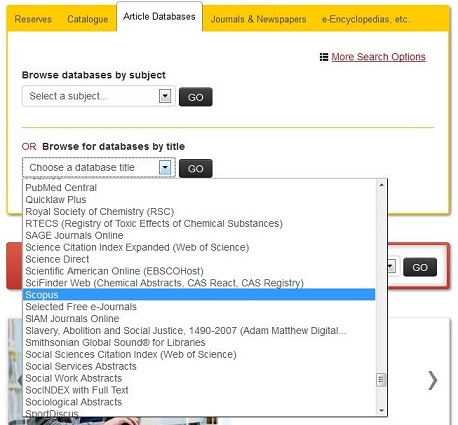
Scopus User Interface
Below is a screen shot of the main search window that appears upon arrival at the Scopus database. Several specific features of this search page are discussed in the expandable Things to Know About this Database text box below the image. In addition, a greater level of detail regarding many of these features will be addressed in later sections.
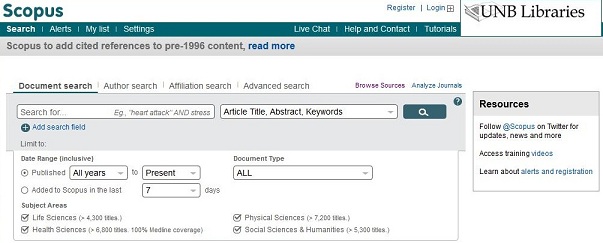
- Things to Know About this Image
-
- Add Search Fields, which is located directly below the main search box, allows you to increase the number of terms you use to define your search. Fields can be connected with AND, OR, and NOT.
- Document Search (located above the main search box) is the equivalent of Advanced Search in other databases. Author and Affiliation Search allow you to view research from specific individuals and institutions, while Advanced Search itself is a complicated Expert Search option that is similar to (but more versatile than) Document Search.
- The drop-down menu to the left of the search box lists the Searchable Fields that are immediately available in Scopus's Document Search. More options may be added in using the codes listed under the Advanced Search option.
- Use Subject Areas (located towards the bottom of the search options) to limit your search results to articles (etc) that fall within one or more of the four broad subject areas listed.
- Select Date Ranges (below the Add Search Fields option) to limit your results to articles and other resources that were published only within a certain time frame. You can also limit results to resources that have only recently been added to Scopus.
- Select Document Type (to the right of the Date Range option) to limit your results to include only a certain type of document (article, review, chapter, editorial, etc.).
Searchable Fields
Searchable fields are the types of information that a database allows you to isolate during a search. These fields are related directly to a given search box, and all items being searched in that box must be retrieved from that field for a search to be successful. As noted in the previous section, searchable field options are typically located to the right of each search box in a database. The most common of these fields are:
Keyword: Keyword searches allow you to search the entire text and associated record available for an article, including article text (when available), abstract, bibliographic information, and subject headings.
- In Scopus the field called Keyword does not perform the traditional keyword search. Instead, it searches keywords that have already been assigned to an article by its author(s) or a professional cataloguer, and these terms tend to be fairly limited in nature. To obtain a typical keyword search in Scopus, try the fields ALL FIELDS or Article, Title, Abstract, Keywords.
Author: In author searches, you can search for articles written by a specific author using his or her name. Author searches are useful in a number of cases:
- If you have found a useful paper, you can search for other papers by the author(s) that wrote it. Often these will cover similar topics, making author searches a good way to increase your relevant results.
- Author searches allow you to learn more about a specific individual's research. This can be useful in familiarizing yourself with researchers with whom you wish to collaborate, or simply with developing an understanding of the work of an incoming researcher/faculty member.
Typically, an author search should be attempted first using only the last name of the author (unless it is something ubiquitous like 'Smith') because some articles don't list authors' full names in their text or records.
Title: Searching for specific words in a title seems like a great idea, and it can be. If your search term appears in a title, then it usually follows that the article is about that topic. However, in order for this to work, you either have to pick the exact right term or list every possible variation for a search term in the search boxes. It is sometimes worth a shot, but is not necessarily your best option.
- Title searches are perfect for one thing: if you're looking for a specific article and you know the title of that article, you can go straight to it using this searchable field.
Abstract: Searching abstracts for specific terms is also great to try, but it suffers from the same pitfalls that title searches do. You either have to get the term right, or you have to list a lot of terms. It's important to approach these searchable fields with these weaknesses in mind.
Subject: Many major databases include some form of subject searching, which is dictated by controlled vocabulary. Scopus has an option similar to this, but it is unstable and unreliable due to the breadth of the subject and journals covered by the database. In general, searches in Scopus must be keyword and other basic level searches.
Boolean Search Operators
Boolean search operators are words or commands that allow you to dictate the relationship between two search boxes, or even between two terms within a search box.
The three most common Boolean operators are:
| AND : the search terms in both (or all) of the connected searchable fields must appear in the items listed in the results. AND is used to narrow searches to more specific topics. | 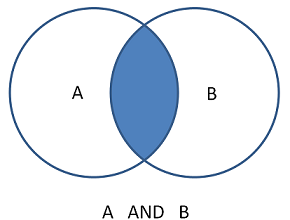 |
| OR : the search terms in at least one of the connected fields must appear in the items listed in the results. OR is used to broaden a search, or to allow for the inclusion of synonyms and alternate word formations. | 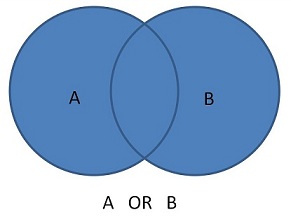 |
| NOT : the search terms in a specific searchable field cannot be included in the items listed in the results. NOT is mainly used to exclude an unrelated concept that uses similar vocabulary, and is rarely used otherwise. NOT narrows search results. | 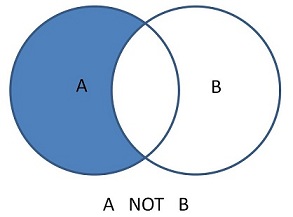 |
In Scopus (and most other databases) the operator AND automatically connects the searchable fields when there are multiple search boxes. This can usually be changed to OR and NOT via drop-down menus, and in most cases it is also possible to add more search boxes to your search screen to connect multiple fields.

- Things to Know About this Image
-
- AND can be changed to OR or NOT in Scopus using the drop-down menus.
- To increase the number of search boxes, click on + Add New Row .
However, search results can become complicated and difficult to predict if you use multiple different Boolean operators in consecutive search boxes. Instead, it is best to change operators within a single search box by using the operator and then the search term, and surround the search term by brackets.
For instance, to connect the keywords maternity nursing and infant development with OR, you can write it as:
("maternity nursing") OR ("infant development")
The same format works for AND and NOT operators.
Grouping Terms
In the last example, note the use of brackets to ‘group terms’ together. This is a way of telling a search engine how to interpret the text you are asking it to search.
In a search string without any brackets, the database reads the string according to its own specific rules of precedence and then in order from left to right.
Scopus’s order of precedence rules are unique to Elsevier, and are such that OR is read before AND, which is, in turn, read before NOT.
For instance,
These searches... A OR B AND CC AND B OR A | Are processed as... |  AND C.jpg) |
Wildcards, Truncation, and Proximity Searching
Wildcards, truncation and proximity searches are still more tools that you can use to improve the reach of your database searches.
Wildcards: allow you to insert an undefined letter into a search term. Some wildcard options also allow you to search for a word in which the added letter may or may not be there. In Scopus, this is done using two separate symbols:
Wildcard - "?" : when using a ? wildcard, insert the ? in place of a letter. Scopus will search that term with all the 26 letters of the alphabet in the location of the ?. For instance:
If you type ne?t
You will receive search results with next, newt, nest, and neat.
Wildcard - "*" : when using a wildcard *, insert the * in the location where there may or may not be an additional letter. For instance:
If you type colo*r
You will receive search results with both color and colour.
Truncation: a means of telling the search engine to look for the search term, as well as all other terms that share the same beginning letters (the letters that come before the truncation symbol). For instance:
If you type comput*
You will receive search results with computer, computing, computational, etc.
Truncation can also be used to represent a word in an exact phrase search. For instance:
If you type "a midsummer * dream"
You will receive search results with "a midsummer night's dream".
Proximity searching: sometimes you will want to find two related words in a document, but you know that they may be separated by another (or several other) words. In this case, you can do a proximity search – that is, you can use the command PRE/ or W/ and the number of intervening words to direct the search engine. For instance:
Preceding Proximity Search: place PRE/# between the words you want to search. Scopus will retrieve cases where the first word preceded the second word by that many (or fewer) words:
If you type (type II) PRE/2 (diabetes)
You will receive search results in which the words type II is two or fewer words before the word diabetes.
Within Proximity Search: place W/# between the words you want to search. Scopus will retrieve cases where the two words are separated (without regards to order) by that many or fewer words:
If you type (type II) W/2 (diabetes)
You will receive search results in which the words type II are within two or fewer words of the word diabetes.
Note: Every database has its own specific symbols for wildcards and truncation. It won’t always be ?, * and # - you will have to look it up. This information is typically found in the ‘Help’ screens of databases under searches or searching.
Phrase Searching
Sometimes when you are doing a search you will know exactly what you are looking for and exactly the right words to retrieve it. You may know a title, or have a quote from the text to guide your search.
For instance, you may be looking for the book The Man who Mistook his Wife for a Hat, by Oliver W. Sacks.
It’s possible (probable, even) that if you typed this phrase into a search engine you would get the actual book as your first result. However, search engines prioritize their results based on a number of different factors. They take into consideration popularity of a search result, the uniqueness of the words used, and frequency of word-use in text, while sometimes de-prioritizing things like connector words (the, and, etc.) and word order.
In order to avoid these issues of prioritization, it is possible to tell a search engine to search for an exact phrase through the use of quotation marks.
For instance, a search for:
"The man who mistook his wife for a hat"
Will only yield results that contain that exact phrase in their texts (in this case, it would most likely be the book itself, reviews of the book, and/or works that cite the book).
This can also be used to search for terms that consist of more than one word, like sport psychology and coaching psychology.
Reading your Search Results
In an effort to provide its users with the greatest possible amount of useful information, Scopus packs each record in its results lists with text and symbols. This is extremely useful when you know what you’re looking at, but equally daunting when you don’t.
To simplify things, there is a (brief) breakdown of the most useful parts of the Scopus's search results in the Things to Know About this Image text box below the screen shot:
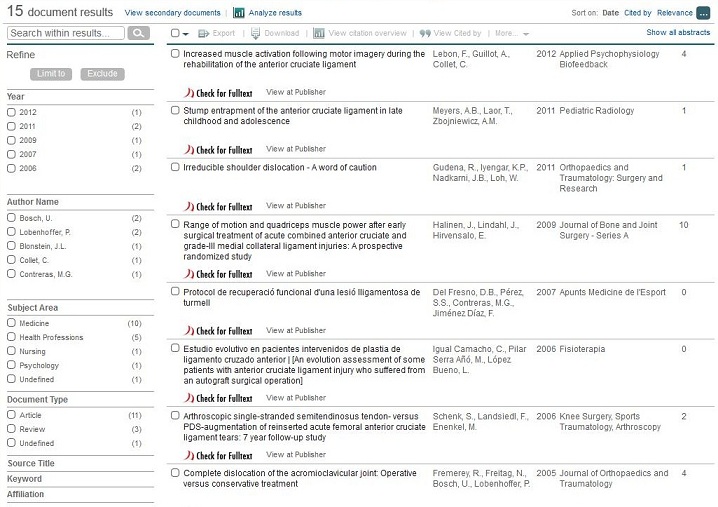
- Things to Know About this Image
-
- Refine, which is located towards the upper left corner of the results screen, allows you to narrow your results according to a number of different limiters.
- Search within results (located above Refine)allows you to add a keyword to your search without restarting that search.
- Show all abstracts, which can be found towards the upper right corner of the results screen, changes the results list so that it shows the abstracts as well as titles.
- Sort on (located above Show all abstracts) allows you to sort results by date, relevance, number of times cited, and more.
- Refining by Keyword (towards the bottom of the Refine options on the left-hand side of the screen) is a unique feature that lists up to 160 keywords present in the results and groups articles by those keywords. This is an excellent way to increase your search specificity without performing a new search.
- Check for Fulltext, which is available at the bottom of most records in the results list, is your link to the full text of the article if it is available (either through Scopus or UNB libraries).
Understanding Records
When you click on the title of an article in the results list, you enter the record associated with that title. This record consists of all the information Scopus uses to index that article - from title, to author, to journal, to article type. It also provides you with many options to help you use and benefit from that article.
Below the image, under Things to Know About this Image, are summaries of some of the most useful options you are likely to see upon entering a record.
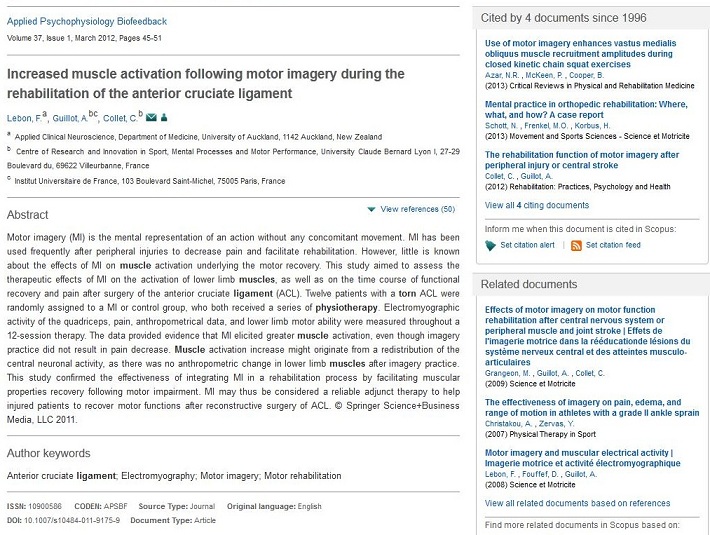
- Things to Know About this Image
-
- Cited by (located in the upper right corner of the record) provides links to the most recent Scopus articles that have cited the work, as well as a count of how many times that work has been cited by others in the Scopus database.
- Related documents (located below the Cited by option) is defaulted to list documents that share references with the article in the record. It can also be changed to produce documents that share authors or keywords.
- Source and Document Type are located towards the bottom of each record in Scopus.
Additional Features in Scopus
Search History
Scopus allows you to go back and repeat or review an old search as long as the session has not been closed or timed out (i.e., as long as you continue to actively use Scopus).
This Search History option allows you to:
- Return to previous searches to view their results
- Recall terms you have used in previous searches
- Combine different searches and search results using Boolean search operators
Search History is displayed prominently on the Scopus search page, and can be accessed by clicking the Search History button in the top left-hand corner of the screen (just below the main Scopus logo). The Search History is located directly below the search boxes on that main page.
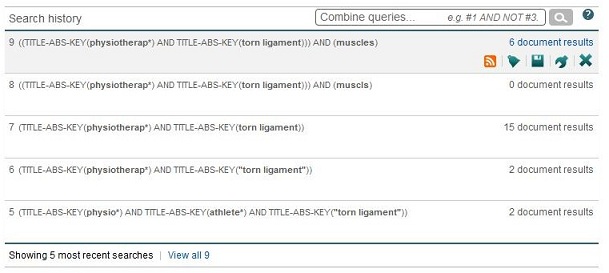
- Things to Know About this Image
-
- Use the Combine queries box (in the upper right corner of the Search History display) to combine previous searches using the Boolean Operators AND, OR, and NOT.
- Save (symbolized by the floppy disc icon in the upper right corner of the Search History display) allows you to save that search in the long-term. It requires that you create a free account with Scopus.
- Edit (symbolized by the wrench icon in the upper right corner of the Search History display) allows you to modify that search string to retrieve new results.
- Select View all (at the bottom of the Search History display) to view your entire search history for that search session.
Keyword Limiter
While Scopus does not have a controlled vocabulary in the same sense that other major databases do (like most ProQuest and EBSCO databases), it does offer a unique Keyword limiter that can be used to refine searches after they have been performed.
Scopus’s Keyword limiter samples all the keywords used to describe documents in the results for a given search, and lists up to 160 of the most common keywords from those results. Beside each of these keywords is a count (in brackets) of the number of articles that use it as a keyword within your search results. You can then select the most appropriate keywords and limit your results to only include the documents containing those keywords.
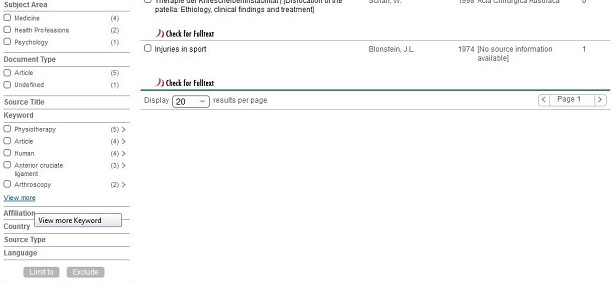
- Things to Know About this Image
-
- Click on Keyword to expand that limiter and view the keyword options for a given set of search results.
- Select View more to obtain a full list of the possible keywords.

- Things to Know About this Image
-
- Limit to narrows your search results until they only include results that also use the selected keywords.
- Exclude acts as the Boolean operator NOT to exclude results that use the selected terms from the results list.
Scopus Accounts
Scopus allows users to create accounts in which they can save searches, and the products of your searches, even after an active search session has closed. In general, the main uses for a Scopus account are:
- Saving search histories to review and use at a later date
- Saving articles and records for later use
- Receiving alerts when new articles on a topic or by an author are released
To create a Scopus account select Register at the top of the Scopus search screen, and enter your information.
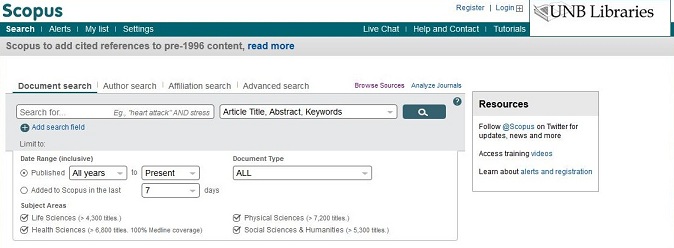
Stumpers: Additional Tips for Finding the Article you Need
- If you can’t find the right subject term, or the subject term you are using isn’t getting you where you need to go, take a look at an article that is related to your topic and use the subject term(s) it uses to guide your future searches.
- Find an article in a field close to your topic and look at:
- Who has cited that article
- Who that article cites (read the reference section)
- What articles are listed as related to that article (either through an option in the database itself, or using Google Scholar)
- What other works the author(s) of that article has produced
- Try a different database.
- Every database subscribed to by UNB contains different information. While some articles may repeat across databases, there will always be substantial new content with each new search engine.
- When doing any research project, a minimum of three databases is recommended. When doing a comprehensive literature review, you should use every available database that touches on your topic to avoid missing relevant information.
- The contents of each database (i.e., the type of resource and the subject areas covered) can typically be obtained by clicking on the details or the options located beside their names on the library website.
Richelle Witherspoon Copyright 2014 UNB Libraries